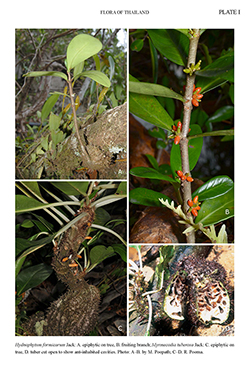e-Flora of Thailand
Volume 15 > Part 1 > Year 2021 > Page 13 > Rubiaceae > Hydnophytum
Hydnophytum formicarum Jackwfo-0000215798
Trans. Linn. Soc. London 14: 124. 1823; Hook.f., Fl. Brit. India 3: 195. 1881, p.p.; Ridl., Fl. Malay Penins. 2: 172. 1923; Pit. in Lecomte, Fl. Indo-Chine 3: 406. 1924; Craib, Fl. Siam. 2: 223. 1934; Jebb & Huxley, Blumea 64: 32. 2019; K.M.Wong, Fl. Singapore 13: 132, fig. 32. 2019.— Lasiostoma formicarum (Jack) Spreng., Syst. Veg. 1: 423. 1824. Plate I: A–B.
Accepted Name : This is currently accepted.
Synonyms & Citations :
Description : Ant-inhabited tuberous epiphyte; tuber cylindrical to globose or rather irregularly shaped, in old individuals up to 25–30 cm long, with entrance holes scattered over its surface, without thorns; apically with several unbranched to branched erect stems to ca 30 cm long. Leaves elliptic to elliptic oblong or obovate, 5–9 by 2.5–6 cm, narrowed to base, apex obtuse, coriaceous, glabrous; petiole 2–5 mm long. Flowers small, bisexual, sessile, in axillary few clusters. Calyx with short tube, truncate above, < 1 mm high. Corolla white; tube hairy around throat, ca 3 mm long; lobes oblong, shorter than to as long as tube. Stamens inserted below throat; anthers subsessile, included in corolla tube. Ovary < 1 mm high; style with 2-lobed stigma included in corolla tube. Drupe orange to orange-red, ovoid, ca 5 mm long, crowned by persistent calyx; pyrenes 2, plano-convex, blackish.
Thailand : EASTERN: Si Sa Ket; SOUTH-EASTERN: Chachoengsao, Chanthaburi, Trat; PENINSULAR: Phangnga, Krabi, Trang, Satun, Songkhla, Narathiwat.
Distribution : Myanmar, Andaman Islands, Cambodia, Vietnam, throughout Malesia to the Moluccas but probably absent from New Guinea (lectotype from Ambon, epitype from Sumatra).
Ecology : In lowland evergreen rainforests, peat swamp forests, beach forests, occasionally in seasonal rainforests. The species does not seem to have any preferred host trees, plants either cling to tree trunks or grow on main crown branches of trees of various heights. Not infrequently forming large populations and often associated with other obligatory or facultative ant-plants such as the ant-fern Lecanopteris (Polypodiaceae) or Dischidia spp. (Apocynaceae), 0–500(?) m alt.
Vernacular : Krachao phimot (กระเช้าผีมด)(Surat Thani); hua roi ru (หัวร้อยรู)(Central); pum pao (ปุมเป้า)(Trat); roi ru (ร้อยรู)(Pattani); da-lu-pu-ta-li-ma (ดาลูปูตาลิมา)(Malay-Peninsular)

